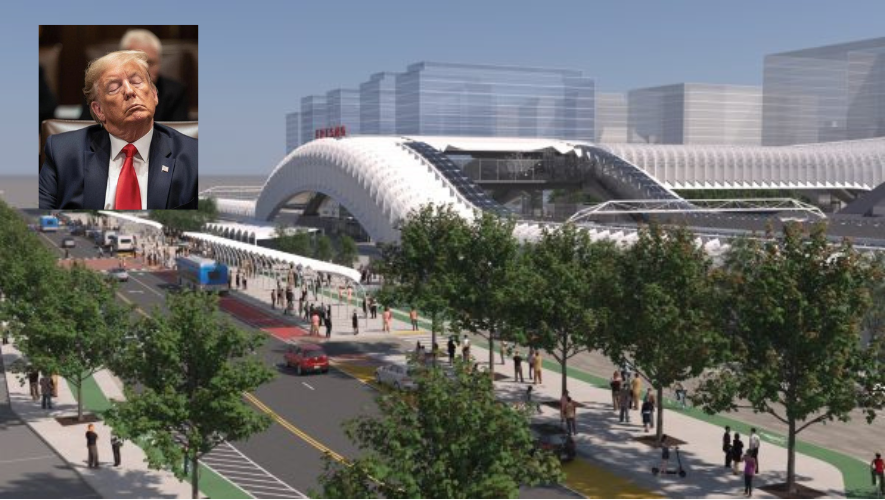Trump’s Attack on California High-Speed Rail: A Fact-Check
Former President Donald Trump, during a press event dominated by discussions of the Gaza Strip, launched an attack on California’s High-Speed Rail (CAHSR) project. He alleged rampant corruption and threatened an investigation, claiming the project was "hundreds of billions of dollars" over budget and poorly managed. However, Trump provided no evidence to support his claims of corruption, and his assertions about the project’s cost and scope are demonstrably inaccurate.
CAHSR representatives and California officials refuted Trump’s accusations. Jim Patrick, a spokesperson for the project, stated that any investigation would confirm the responsible use of funds, citing ongoing land acquisitions, train purchases, and construction progress within budget constraints. Fresno Mayor Jerry Dyer, a Republican, acknowledged delays but emphasized the project’s pioneering nature as the first high-speed rail system in the United States. While expressing interest in the results of any investigation, Dyer stressed the importance of completing the project.
A closer examination of Trump’s claims reveals significant factual inaccuracies. Firstly, there is no evidence of corruption or kickbacks related to CAHSR funds. Secondly, the project’s cost overruns, while substantial, are not in the "hundreds of billions." The current estimated cost is $125 billion, up from the original $45 billion, a significant increase, but far less than Trump’s exaggerated figure. These increased costs are largely attributable to land acquisition expenses, necessary highway and road adjustments, and inflation stemming from project delays, many of which were politically motivated.
Trump also misrepresented the project’s scope, falsely claiming it was "much shorter" than initially planned and no longer connecting to San Francisco and Los Angeles. The initial phase currently under construction focuses on the Central Valley, but the long-term plan remains to connect the Bay Area, Los Angeles, and San Diego. In fact, the project has already contributed to the successful electrification of Caltrain, connecting San Jose and San Francisco, demonstrating tangible progress.
Furthermore, Trump’s suggestion of replacing high-speed rail with limousine service for travelers between Los Angeles and San Francisco is economically absurd. Analysis by the U.S. High-Speed Rail Association reveals the staggering cost of such an endeavor. Based on even conservative estimates, providing limousine service for the projected 30 million annual passengers would cost hundreds of billions of dollars annually, dwarfing the one-time construction cost of the rail system. Even using ride-sharing services, the cost per trip multiplied by the projected ridership demonstrates the impracticality of Trump’s proposal.
The environmental benefits of CAHSR are also significant. The project is projected to reduce greenhouse gas emissions by over 100 million metric tons of carbon dioxide equivalent over 50 years, along with other harmful pollutants. It will also significantly reduce travel time between major California cities. Driving from Los Angeles to San Francisco currently takes about six hours without stops; high-speed rail will more than halve that time, providing a faster and more sustainable transportation option.
Trump’s attack on CAHSR appears to be based on misinformation and hyperbole. While the project has faced cost increases and delays, his claims of "hundreds of billions" in overruns, corruption, and a drastically reduced scope are unsupported by facts. The project continues to move forward, promising significant economic, environmental, and transportation benefits for California.
It is also worth noting the disparity in scrutiny applied to CAHSR compared to other large infrastructure projects. Highway projects, such as the I-69 expansion, have experienced significant cost overruns and delays over decades with far less public criticism and investigation. This raises questions about the motivation behind Trump’s specific targeting of CAHSR.
The CAHSR project is a complex undertaking with its share of challenges. However, it represents a significant investment in California’s future, offering a faster, cleaner, and more efficient transportation system. Objective analysis and accurate information are crucial to evaluating the project’s progress and addressing its challenges, rather than relying on unfounded accusations and misleading rhetoric.
The ongoing debate surrounding CAHSR highlights the importance of informed public discourse. Understanding the factual basis of claims and counterclaims is essential for making sound judgments about complex infrastructure projects. While cost overruns and delays are legitimate concerns, they should be addressed through rigorous oversight and accountability, not through politically motivated attacks based on misinformation.
The future of CAHSR remains a subject of ongoing discussion and debate. However, discarding the project based on unfounded allegations and exaggerated claims would be a disservice to the potential benefits it offers. Continued investment in sustainable transportation infrastructure is crucial for addressing climate change, improving air quality, and enhancing mobility in California.
The controversy surrounding CAHSR underscores the need for transparency and accountability in large infrastructure projects. Open access to information, independent audits, and public hearings can help ensure that projects are managed effectively and that public funds are used responsibly. Constructive dialogue based on facts, not rhetoric, is essential for making informed decisions about the future of transportation in California.
The comparison between CAHSR and other infrastructure projects raises important questions about priorities and scrutiny. Why does a project aimed at reducing greenhouse gas emissions and improving public transportation face such intense criticism, while highway projects with comparable cost overruns and delays receive less attention? These are questions that deserve further examination and public discussion.
Ultimately, the success of CAHSR will depend on effective management, sound financial planning, and continued public support. Overcoming the challenges and realizing the project’s full potential will require collaboration between government, industry, and the public. Informed decision-making based on facts, not political rhetoric, is crucial for ensuring that California invests wisely in its future transportation infrastructure.


